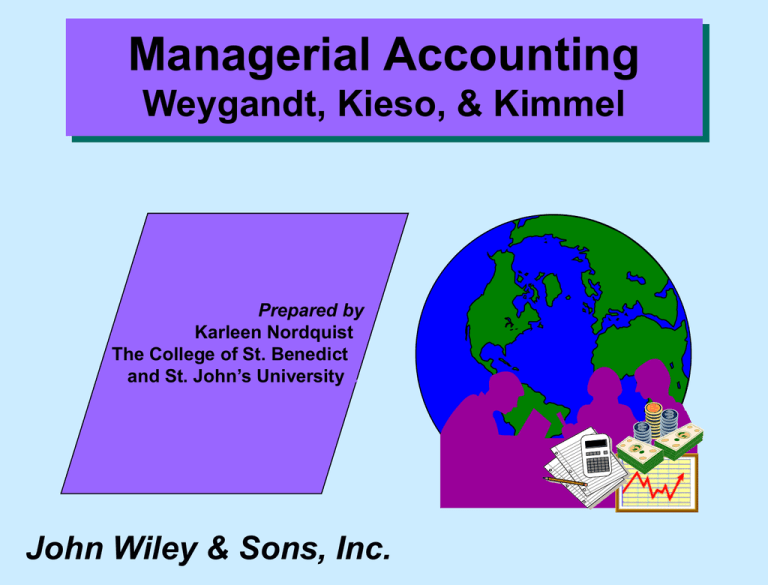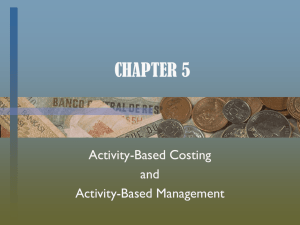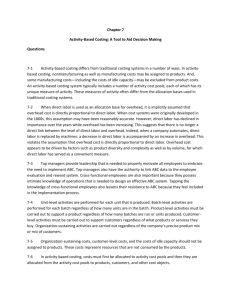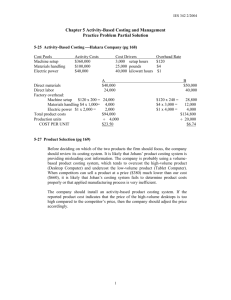
Managerial Accounting
Weygandt, Kieso, & Kimmel
Prepared by
Karleen Nordquist..
The College of St. Benedict...
and St. John’s University....
John Wiley & Sons, Inc.
Chapter 4
Activity-Based Costing
Chapter 4
Activity-Based Costing
After studying this chapter, you should be able to:
1 Recognize the difference between traditional costing
and activity-based costing.
2 Identify the steps in the development of an activitybased costing system.
3 Identify the activity cost pools used in activity-based
costing.
4 Identify and use the activity cost drivers in activitybased costing.
Chapter 4
Activity-Based Costing
After studying this chapter, you should be able to:
5 Understand the benefits and limitations of activitybased costing.
6 Differentiate between value-added and nonvalueadded activities.
7 Understand the value of a hierarchy of activity levels
to activity-based costing.
8 Explain just-in-time (JIT) processing.
Preview of Chapter 4
ABC vs. Traditional Costing
ACTIVITYBASED
COSTING
• Traditional Costing Systems
• Need for New Costing Systems
• Activity-Based Costing
Illustration of Traditional
Costing Versus ABC
• Unit Costs Under Traditional
Costing
• Unit Costs Under ABC
• Comparing Unit Costs
Preview of Chapter 4
ABC: A Closer Look
ACTIVITYBASED
COSTING
• Benefits
• Limitations
• When to Switch to ABC
• Value-Added Versus NonvalueAdded Activities
• Hierarchy of Activity Levels
Just-in-Time Processing
• Objective
• Elements
• Benefits
Study Objective 1
Recognize the difference between
traditional costing and activitybased costing.
Traditional Costing
Systems
Often the most difficult part of computing
accurate unit costs is determining the proper
amount of overhead cost to assign to each
product, service, or job.
Unlike direct materials and direct labor costs
which can usually be easily traced to the
product, overhead is an indirect or common
cost that generally cannot be traced to a
product.
Traditional Costing
Systems
In Chapters 2 and 3 a single predetermined
overhead rate was used throughout the year
to assign costs to products.
We assumed that direct labor cost and
machine hours were the relevant activity
bases for the assignment of all overhead in
job order and process costing, respectively.
Traditional Costing
Systems
When overhead cost allocation systems were first developed,
direct labor made up a large part of total manufacturing cost.
It was widely accepted that there was a high correlation
between direct labor and the incurrence of overhead cost. As
a result, direct labor became the most popular basis for
overhead allocation.
A simplified (one-stage) traditional costing system relying on
direct labor to assign overhead is displayed below:
Overhead
Costs
Direct
Labor
Hours
Products
Illustration 4-2
Traditional Costing
Systems
Even in today’s environment, direct labor is
often the appropriate basis for assigning
overhead cost to products.
It is appropriate when
– direct labor constitutes a significant part of
total product cost, and
– a high correlation exists between direct
labor and changes in the amount of
overhead costs.
The Need for a New Costing
System
Advances in computerized systems, technological
innovation, international competition, and
automation have changed the manufacturing
environment drastically. The amount of direct labor
used in many industries is now greatly reduced, and
total overhead costs have significantly increased.
Companies that continue to use plantwide
predetermined overhead rates based on direct labor,
where the correlation between direct labor and
overhead no longer exists, experience significant
product cost distortions.
The Need for a New Costing
System
Recognizing these distortions, many companies now
use machine hours as the overhead allocation base
in an automated manufacturing environment.
But even machine hours may not suffice as the sole
plantwide basis for allocating all overhead.
If the manufacturing process is complex, then only
multiple allocation bases can result in more accurate
computations.
In such situations, managers need a new overhead
cost allocation method: activity-based costing.
Activity-Based Costing
Activity-based costing (ABC) allocates overhead to
multiple activity cost pools and assigns the activity
cost pools to production by means of cost drivers.
In ABC, an activity is any event, action, transaction,
or work sequence that causes the incurrence of cost
in the production of a product or rendering of a
service.
A cost driver is any factor or activity that has a
direct cause/effect relationship with the resources
consumed.
Activity-Based Costing
ABC first allocates costs to activities, and
then to the products based on each product’s
use of those activities.
The reasoning behind ABC cost allocation is
simple: products consume activities;
activities consume resources.
Activity-Based Costing
ABC allocates overhead in a two-stage process:
– Overhead is allocated to activity cost
–
pools, each of which is a distinct type of
activity,
Overhead in the cost pools is assigned to
products using cost drivers which represent
and measure the number of individual
activities undertaken or performed to
produce products or render services.
Activity-Based Costing
Not all products or services share equally in activities.
The more complex a product’s manufacturing
operation, the more activities and cost drivers it is
likely to have.
If there is little or no correlation between changes in
the cost driver and consumption of the overhead cost,
inaccurate product costs are inevitable.
The next slide shows an illustration of an activitybased costing system with seven activity cost pools
and correlated cost drivers.
Activity-Based Costing
System
Overhead Costs
Ordering
and
Receiving
Materials
Cost Pool
Setting
Up
Machines
Cost Pool
Numbe
r of
POs
Numbe
r of
Setups
Machining
Cost Pool
Assembling
Cost Pool
Inspecting
and
Testing
Cost Pool
Painting
Cost Pool
Supervising
Cost Pool
Machin
e Hours
Numbe
r of
Parts
Numbe
r of
Tests
Numbe
r of
Parts
Direct
Labor
Hours
Products
Illustration 4-4
Illustration of Traditional
Costing versus ABC
A simple case example will now be presented to compare
traditional costing and activity-based costing. It illustrates
the distortion that can occur in traditional overhead cost
allocation.
Atlas Company products two automobile anti-theft devices,
The Boot and The Club. The Boot is a high-volume item,
totaling 25,000 units annually, while The Club is a low-volume
item totaling only 5,000 units a year. Both products require
one hour of direct labor. Therefore, annual direct labor hours
are 30,000. Expected annual manufacturing overhead costs are
$900,000. Thus, the predetermined overhead rate is $30
($900,000 30,000) per direct labor hour.
Unit Costs Under
Traditional Costing
The direct materials cost per unit is $40 for The
Boot and $30 for The Club. The direct labor cost is
$12 for each product.
The computation of the unit cost for The Boot and
The Club under traditional costing is shown below:
Atlas Company
Products
Manufacturing Costs
Direct material
Direct labor
Overhead
Total unit cost
The Boot
$40
12
30*
$82
The Club
$30
12
30*
$72
*Predetermined overhead rate times direct labor hours ($30 x 1 hr. = $30)
Illustration 4-5
Study Objective 2
Identify the steps in the development
of an activity-based costing system.
Unit Costs under ABC
Activity-based costing involves the following steps:
1 Identify the major activities that pertain to the
manufacture of specific products and allocate
manufacturing overhead costs to activity cost pools.
2 Identify the cost drivers that accurately measure each
activity’s contributions to the finished product and
compute the activity-based overhead rate.
3 Assign manufacturing overhead costs for each activity
cost pool to products using the activity-based overhead
rates (cost per driver).
Study Objective 3
Identify the activity cost pools used
in activity-based costing.
Identifying Activities
A well designed activity-based costing system starts with
an analysis of the activities performed to manufacture a
product. This analysis should identify all resourceconsuming activities.
Atlas Company identified three activity cost pools:
setting up machines, machining, and inspecting.
Allocating Overhead to
Cost Pools
After the activity cost pools are identified, overhead
costs are assigned directly to activity cost pools.
Atlas Company’s activity cost pools, along with with
estimated overhead allocated to each activity cost pool are
shown below:
Atlas Company
Activity Cost Pools
Setting up machines
Machining
Inspecting
Total
Estimated
Overhead
$300,000
500,000
100,000
$900,000
Illustration 4-6
Study Objective 4
Identify and use the activity cost
drivers in activity-based costing.
Identifying Cost Drivers
After costs are allocated to the activity cost pools, the cost
drivers for each activity cost pool must be identified. To
achieve accurate costing, a high degree of correlation must
exist between the activity cost driver and the actual
consumption of the activity cost pool.
The cost drivers identified by Atlas and their total expected use
per activity cost pool are shown below:
Atlas Company
Activity Cost Pools
Setting up machines
Machining
Inspecting
Cost Drivers
Number of setups
Machine hours
Number of inspections
Expected Use of
Cost Drivers
per Activity
1,500 setups
50,000 machine hours
2,000 inspections
Illustration 4-7
Computing Overhead Rates
Availability and ease of obtaining data relating
to the activity cost driver is an important
factor that must be considered in its selection.
The activity-based overhead rate is computed
as shown below:
Estimated
Overhead per
Activity
Expected Use of
Cost Drivers per
Activity
=
Activity-based
Overhead Rate
Computing Overhead Rates
Atlas Company’s computations of its activitybased overhead rates are below:
Atlas Company
Activity Cost Pools
Setting up machines
Machining
Inspecting
Total
Estimated
Overhead
$300,000
500,000
100,000
Expected Use of
Cost Drivers
per Activity
1,500 setups
50,000 machine hours
2,000 inspections
=
Activity-Based
Overhead Rates
$200 per setup
$10 per machine hour
$50 per inspection
$900,000
Illustration 4-9
Assigning Overhead Costs
to Products under ABC
In assigning overhead costs, it is necessary to know the
expected use of cost drivers for each product.
Because of its low volume, The Club requires more setups and
inspection than The Boot. The expected use of cost drivers per
product is shown below:
Atlas Company
Expected Use
of Cost Drivers
per Product
Activity Cost Pools
Cost Drivers
Setting up machines
Number of setups
Machining
Machine hours
Inspecting
Number of inspections
Expected Use of
Cost Drivers
per Activity
The Boot
1,500 setups
500
50,000 machine hours
30,000
2,000 inspections
500
The Club
1,00
20,000
1,500
Illustration 4-10
Assigning Overhead Costs
to Products under ABC
To assign overhead costs to each product, the activity-based
overhead rates are multiplied by the number of cost drivers
expected to be used per product.
The assignment of Atlas Company’s estimated annual
overhead cost to The Boot is shown below. Estimated
overhead assigned to The Club is shown on the next slide.
Atlas Company: The Boot
Expected Use
of Cost Drivers
per Product
Activity Cost Pools
500
Setting up machines
30,000
Machining
500
Inspecting
Total assigned costs (a)
Units produced (b)
Overhead cost per unit (a) (b)
x
Activity-Based
Overhead
Rates
$200
$ 10
$ 50
=
Cost
Assigned
$100,000
300,000
25,000
$425,000
25,000
$17
Illustration 4-11a
Assigning Overhead Costs
to Products under ABC
Atlas Company: The Club
Expected Use
of Cost Drivers
per Product
Activity Cost Pools
1,000
Setting up machines
20,000
Machining
1,500
Inspecting
Total assigned costs (a)
Units produced (b)
Overhead cost per unit (a) (b)
x
Activity-Based
Overhead
Rates
$200
$ 10
$ 50
=
Cost
Assigned
$200,000
200,000
75,000
$475,000
5,000
$95
Illustration 4-11b
These data show that under ABC, overhead
costs are shifted from the high volume product
(The Boot) to the low-volume product (The
Club).
Assigning Overhead Costs
to Products under ABC
This shift of overhead from high to low volume
products results in more accurate costing for two
reasons:
– Low-volume products often require more special
handling, such as setups. Thus, the low-volume
product is responsible for more overhead costs per
unit than a high-volume product.
– The overhead costs incurred by the low-volume
product often are disproportionate to a traditional
allocation base such as direct labor hours.
Comparing Unit Costs
Atlas Company
Manufacturing Costs
Direct materials
Direct labor
Overhead
Total cost per unit
The Boot
Traditional
ABC
Costing
$40
$40
12
12
17
30
$82
$69
The Club
Traditional
ABC
Costing
$ 30
$30
12
12
95
30
$72
$137
The comparison shows that unit costs under traditional
costing are significantly distorted. The cost of
producing The Boot is overstated $13 per unit and the
cost of producing The Club is understated $65 per unit.
Comparing Unit Costs
The differences in cost per unit are
attributable entirely to how manufacturing
overhead is assigned.
A likely consequence of the differences is that
Atlas Company has been overpricing The
Boot and possibly losing market share to
competitors. In addition, it has been
sacrificing profitability by underpricing The
Club.
Study Objective 5
Understand the benefits and
limitations of activity-based costing.
Benefits of ABC
The primary benefit of ABC is more accurate product
costing because:
ABC leads to more cost pools used to assign
overhead costs to products. Instead of one pool and
one driver, numerous activity cost pools with more
relevant cost drivers are utilized.
ABC leads to enhanced control over overhead
costs. Many overhead costs can be traced directly to
activities. Thus, managers become more aware of
their responsibility to control the activities that
generate costs.
Benefits of ABC
ABC leads to better management decisions. More
accurate product costing helps in setting selling
prices and in deciding to whether make or buy
components.
Activity-based costing does not, in and of itself,
change the amount of overhead costs, but it does in
certain circumstances allocate those costs in a more
accurate manner. And, if the score-keeping is more
realistic, more accurate, and better understood,
managers should be able to better understand cost
behavior and overall profitability.
Limitations of ABC
Although ABC systems often provide better product cost
data than traditional volume-based systems, there are
limitations.
ABC can be expensive to use. ABC systems are more
complex than traditional costing systems. There is a
cost to identifying multiple activities and applying
numerous cost drivers.
Some arbitrary allocations continue. Even though
more overhead costs can be assigned directly to
products, certain overhead costs remain to be allocated
by means of some arbitrary volume-based cost driver.
When to Switch to ABC
The presence of one or more of the following factors
indicates ABC as the superior costing system:
Product lines differ greatly in volume and
manufacturing complexity.
Product lines are numerous, diverse, and require
differing degrees of support services.
The manufacturing process or the number of products
has changed significantly.
Production or marketing managers are ignoring data
provided by the existing system, and are instead using
alternative data in making decisions.
When to Switch to ABC
The redesign and installation of a new productcosting system is a significant decision that
requires considerable cost and a major effort to
accomplish. Therefore, financial managers need
to be very cautious and deliberative when
initiating changes in costing systems.
Study Objective 6
Differentiate between value-added
and nonvalue-added activities.
Activity-Based Management
Activity-based management (ABM) is an
extension of ABC from a product costing
system to a management function that focuses
on reducing costs and improving processes
and decision making.
A refinement of activity-based costing used in
ABM is the classification of activities as
either value-added or nonvalue-added.
Value-Added versus
Nonvalue-Added Activities
Value-added activities increase the worth of a
product or service to customers.
They involve resource usage and related costs
that customers are willing to pay for.
Value-added activities are the functions of
actually manufacturing a product or service.
Examples include engineering design,
machining, assembly, painting, and packaging.
Value-Added versus
Nonvalue-Added Activities
Nonvalue-added activities are production- or
service-related activities that simply add cost to,
or increase the time spent on, a product or
service without increasing its market value.
Examples include the repair of machines,
storage of inventory, moving of materials,
maintenance, and inspections.
Identifying and labeling activities as value-added
or nonvalue-added is part of the analysis of
operations, the first step, in an ABC system.
Value-Added versus
Nonvalue-Added Activities
Not all activities labeled nonvalue-added are
totally wasteful, nor can they be totally
eliminated.
For example, although inspection is a nonvalueadded activity from a customer’s perspective,
few companies would eliminate their quality
control functions. Similarly, moving and
waiting time is nonvalue-added, but it would be
impossible to completely eliminate.
Value-Added versus
Nonvalue-Added Activities
Nevertheless, because mangers recognize the
nonvalue-added characteristic of these
activities, they are motivated to minimize
them as much as possible.
Attention to such matters is part of the
growing practice of activity-based
management which helps managers
concentrate on continuous improvement of
operations and activities.
Study Objective 7
Understand the value of a hierarchy
of activity levels to activity-based
costing.
Hierarchy of Activity Levels
The recognition that not all activity costs are driven by
output units has led to the development of a hierarchy of
ABC activities:
– Unit-level activities are performed for each unit of
production. (Ex.: materials)
– Batch-level activities are performed for each batch of
products. (Ex.: setups)
– Product-level activities are performed in support of an
entire product line. (Ex.: design)
– Facility-level activities are required to support or
sustain an entire production facility. (Ex.: security)
Hierarchy of Activity Levels
Failure to recognize this hierarchy of activities is
one of the reasons that volume-based cost
allocation causes distortions in product costing.
The resources consumed by batch-, product-, and
facility-level supporting activities do not vary at
the unit-level, and cannot be controlled at the
unit-level. Dividing these types of costs by the
number of units produced gives the mistaken
impression that these costs vary with the number
of units.
Study Objective 8
Explain just-in-time (JIT)
processing.
Just-in-Time Processing
Many U.S firms have switched from a traditional
“just in case” approach to production to just-intime (JIT) processing.
JIT minimizes inventory storage and waiting
time, which are nonvalue-added activities.
Under JIT processing, raw materials are
received just in time for use in production, subassembly parts are completed just in time for
use in finished goods, and finished goods are
completed just in time to be sold.
Objective of JIT Processing
A primary objective of JIT is to eliminate all
manufacturing inventories.
JIT strives to do this by using a pull
approach to production, instead of the
traditional “push approach” which often
results in the buildup of extensive inventories.
Elements of JIT Processing
The three important elements in JIT processing are:
Dependable suppliers willing to deliver exact
quantities of materials that meet precise quality
specifications on short notice.
A multi-skilled work force.
A total quality control system (which means no
defects) throughout all manufacturing operations.
Benefits of JIT Processing
The major benefits of JIT processing are:
Manufacturing inventories are significantly
reduced or eliminated.
Product quality is enhanced.
Rework costs and inventory storage costs are
reduced or eliminated.
Production cost savings are realized from the
improved flow of goods through the process.
Appendix 4A
Activity-Based Costing in Service
Industries
Appendix 4A
Study Objective 9
Apply activity-based costing to
service industries.
Appendix 4A
Activity-Based Costing in Service
Industries
Although initially developed and implemented
by manufacturing companies that produce
products, ABC has been widely adopted in
service industries.
The overall objective of ABC in service firms
is no different than it is in manufacturing
company: to identify the activities that
generate costs and to keep track of how many
of those activities are performed for each
service that is rendered.
Appendix 4A
Activity-Based Costing in Service
Industries
The general approach to identifying activities,
activity cost pools, and cost drivers is the
same for service and manufacturing
companies.
Labeling activities as value-added and
nonvalue-added, and trying to reduce or
eliminate nonvalue-added activities is just as
valid in service industries.
Appendix 4A
Activity-Based Costing in Service
Industries
Classifying activities as unit-level, batchlevel, product-level, and facility-level also
applies to service industries.
What sometimes makes implementation of
ABC difficult in service industries is that a
larger proportion of overhead costs are
facility-level costs that cannot be directly
traced to specific services rendered by the
company.
Copyright
Copyright © 1999 John Wiley & Sons, Inc. All rights reserved.
Reproduction or translation of this work beyond that named in
Section 117 of the 1976 United States Copyright Act without the
express written permission of the copyright owner is unlawful.
Request for further information should be addressed to the
Permissions Department, John Wiley & Sons, Inc. The purchaser
may make back-up copies for his/her own use only and not for
distribution or resale. The Publisher assumes no responsibility for
errors, omissions, or damages, caused by the use of these programs
or from the use of the information contained herein.
Chapter 4
Activity-Based Costing





